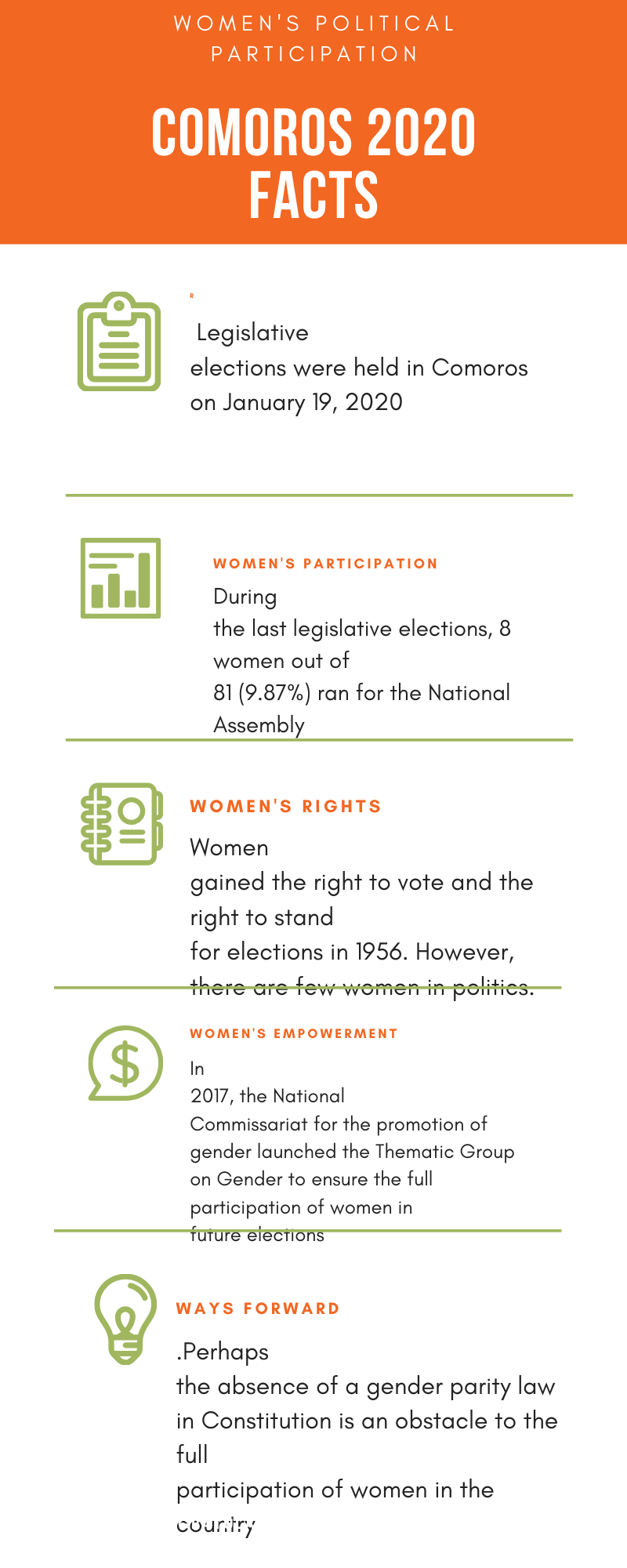Legislative elections were held in Comoros on January 19, 2020. Comoros’ ruling party won an absolute majority conquering 17 out of 24 legislative seats.
However, the first round of the parliamentary election was boycotted by opposition parties asking for "transparent, free and democratic" election. A second round was therefore held on February 23. This time, the President Azali Assoumani’s Convention for the Renewal of the Comoros won 20 out of 24 seats.
The Union of the Comoros consists of a group of three islands. Since its independence from France, the Union experienced more than 20 coups. The country is now trying to consolidate political stability. None of the leaders of the country have been women. In 2010, Comoros had its first female presidential candidate, but she did not pass the first round of voting. In 2015, another woman ran for President, failing to compete in the runoff election. Generally, women’s political participation has been critically low.
Comoros has a weak party structure: there is a large number of parties, mainly based on personal loyalties. The country has a rotating presidency and the President is elected for a single five-year term. In 2018, a constitutional referendum allowed President Azali Assoumani to be elected a second time in 2019. Comoros has a unicameral legislature with 33 seats. Of those seats, 24 are directly elected and the remaining nine seats are nominated by the three island parliaments. There is no gender parity quota to encourage and guarantee the participation of women in public life.
Women’s Political Participation
Women gained the right to vote and the right to stand for elections in 1956. However, there are few women in politics. Just one woman conquered a seat in Parliament, so that the percentage of women in Comoros National Assembly is of 3%. Not much has changed: between 2010 and 2016, only one woman was occupying a seat in parliament, making up 3% of the total. The quota doubled (6.06%) in 2017, when a second woman joined parliament.
Although there has been a decrease from 2017 to today’s elections leaving only one woman among 32 men-parliamentarians, female participation has increased. In 2015 and 2016 elections, around 3.76% of candidates for the National Assembly were women; 5.4% of Counsel; 4.5% for Governors; and 3.7% for President. During the last legislative elections, 8 women out of 81 (9.87%) ran for the National Assembly. This highlights that women are more involved in the political landscape of Comoros.
The Comorian Government has recognized the importance of gender mainstreaming and full participation of women. In 2017, the National Commissariat for the promotion of gender launched the Thematic Group on Gender to ensure the full participation of women in future elections by working on changing the traditional perceptions of women. In a 2013 analysis, Comoros has been elected “the best country in the Arab world for women” coming top for reproductive rights, women’s involvement in economy and women in family life. Despite these achievements, the political participation of Comorian women places the country at the bottom of the African Union rankings.
Conclusion
The Union of Comoros is going under tensions resulted from the contested referendum held in 2018 that enabled the president to hold two five-year mandates. Tensions persisted during this last legislative election where the opposition parties failed to obtain satisfying guarantees for fair election. Perhaps the absence of a gender parity law in Constitution is an obstacle to the full participation of women in the country. The Comorian Government could keep on strengthening gender policies to promote women’s involvement in the political sphere and increase the number of female members in the Parliament.
